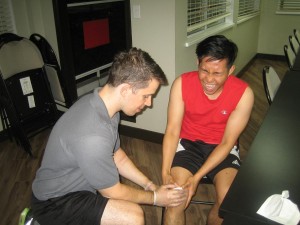In every knee joint, there are two crescent-shaped cartilage called as menisci which cushion and support the knee. These can be injured by twisting or when subjected to traumatic injury as well as degeneration as an individual starts to age which is called as a lateral meniscus tear.
What are the symptoms?
The indications of a torn lateral meniscus usually include pain and tenderness around the exterior knee surface, especially alongside the joint line. Swelling is usually present which appears within 24-48 hours after the injury was sustained.
Pain is also felt when the individual bends the knee or when squatting down. The doctor will perform a full knee assessment including the McMurray’s test in order to confirm a diagnosis.
Treatment

The treatment for a lateral meniscus tear is initially conservative which includes adequate rest. Once this approach does not work, the doctor might recommend surgery.
In case there is swelling, the RICE method (rest, ice, compression, elevation) is used. Mild exercises will help maintain the strength of the quadriceps muscles in the thigh, but care must be observed in order to avoid aggravating the symptoms. Using a knee support will also help protect the joint while it heals. In most cases, a glucosamine joint supplement can be beneficial to promote healing of cartilage injuries. If you want to learn more on how to effectively provide the RICE method, register for a first aid class. (Read here for more information about the classes offered).
When to consult a doctor
The sports injury professional can properly diagnose the injury. This is usually done by utilizing specific tests for meniscal tears such as McMurray’s test. Once an accurate diagnosis is made, it is used in order to determine if it requires conservative treatment without require knee surgery or if surgical intervention is the best solution.
Conservative treatment is usually indicated for a small-sized tear or degenerative meniscus which includes the following:
- RICE method (rest, ice, compression, elevation)
- Administration of NSAIDs
- Using a knee support or brace if there is knee instability
- Electrotherapy such as laser therapy, ultrasound and TENS
Once the pain has reduced, the individual should engage in exercise to increase the range of movement, balance as well as maintain the strength of the quadriceps. The exercise routine must include single calf raises, squatting and even wobble board techniques later on.
Surgical intervention
For severe cases of lateral meniscus tears, arthroscopic surgery might be required in order to repair the lesion. The objective of surgical intervention is to maintain the remaining meniscus cartilage if possible. Take note that the procedure normally involves stitching of the torn out cartilage. Remember that the success of the surgery usually depends not just on the severity of the tear but also the age and physical condition of the individual. Individuals who are younger and fitter usually end up with better outcomes.
Right after surgery, a rehabilitation program will be outlined for the individual which includes strengthening and balance training. Full cooperation with the rehabilitation is needed in order to maximize the recovery.
